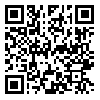Fri, Nov 21, 2025
| فارسی
Volume 30, Issue 1 (Continuously Updated 2024)
IJPCP 2024, 30(1): 0-0 |
Back to browse issues page
Download citation:
BibTeX | RIS | EndNote | Medlars | ProCite | Reference Manager | RefWorks
Send citation to:



BibTeX | RIS | EndNote | Medlars | ProCite | Reference Manager | RefWorks
Send citation to:
Baradaran Eftekhari M, Dejman M, Falahat K, Mahmoudi Z, Forouzan A S. Developing and Evaluating a Transdiagnostic Intervention for Mental Disorders Using the Common Elements Treatment Approach in Iranian Adults. IJPCP 2024; 30 (1) : 2669.5
URL: http://ijpcp.iums.ac.ir/article-1-4112-en.html
URL: http://ijpcp.iums.ac.ir/article-1-4112-en.html
Monir Baradaran Eftekhari1 

 , Masoumeh Dejman2
, Masoumeh Dejman2 

 , Katayoun Falahat3
, Katayoun Falahat3 

 , Zohreh Mahmoudi4
, Zohreh Mahmoudi4 

 , Ameneh Setareh Forouzan2
, Ameneh Setareh Forouzan2 




 , Masoumeh Dejman2
, Masoumeh Dejman2 

 , Katayoun Falahat3
, Katayoun Falahat3 

 , Zohreh Mahmoudi4
, Zohreh Mahmoudi4 

 , Ameneh Setareh Forouzan2
, Ameneh Setareh Forouzan2 


1- Undersecretary for Research and Technology, Ministry of Health and Medical Education, Tehran, Iran. , mbeftekhari200@gmail.com
2- Social Welfare Rehabilitation Research Center, University of Social Welfare and Rehabilitation Sciences, Tehran, Iran.
3- Undersecretary for Research and Technology, Ministry of Health and Medical Education, Tehran, Iran.
4- Social Determinants of Health Research Center, Alborz University of Medical Sciences, Karaj, Iran.
2- Social Welfare Rehabilitation Research Center, University of Social Welfare and Rehabilitation Sciences, Tehran, Iran.
3- Undersecretary for Research and Technology, Ministry of Health and Medical Education, Tehran, Iran.
4- Social Determinants of Health Research Center, Alborz University of Medical Sciences, Karaj, Iran.
Abstract: (1826 Views)
Objectives Mental disorders contribute to a significant global disease burden worldwide. The present study aims to develop and evaluate a transdiagnostic intervention based on the common elements treatment approach (CETA) for mental disorders in Iranian adults.
Methods This mixed-method study (qualitative/quantitative) was conducted in Semnan province, Iran. In the qualitative stage, interviews were conducted using the free listing technique with 20 community members and 10 key informants to extract the common mental disorders. Then, a tool for screening these disorders was designed, and its face validity, content validity, and criterion validity were determined. Next, the CETA-based transdiagnostic program for the treatment of these mental disorders was developed, and three training workshops on implementing the intervention program were held for 30 healthcare providers. Finally, a randomized clinical trial was conducted on 500 adults with mental disorders referred to health centers in Semnan province in two groups of intervention (receiving the CETA-based program) and control (routine treatment), and the effectiveness of the intervention was evaluated.
Results Three mental disorders, including depression, anxiety, and obsessive-compulsive disorder (OCD), were identified in the qualitative phase. The designed screening tool for measuring these disorders was a valid and reliable tool with 76 items. In this tool, the cut-off points for depression, anxiety, and OCD were 14, 17, and 6, respectively. In evaluating the effectiveness of transdiagnostic intervention, the results showed that the mean scores of depression (P<0.001), anxiety (P<0.001), and OCD (P<0.05) significantly decreased after intervention in both control and intervention groups, where the CETA-based intervention was more effective than the routine treatment.
Conclusion The CETA-based transdiagnostic intervention, delivered by healthcare providers to adults with depression, anxiety, and OCD, is a feasible and effective method and can be used to increase the mental health of adults in Iran.
Methods This mixed-method study (qualitative/quantitative) was conducted in Semnan province, Iran. In the qualitative stage, interviews were conducted using the free listing technique with 20 community members and 10 key informants to extract the common mental disorders. Then, a tool for screening these disorders was designed, and its face validity, content validity, and criterion validity were determined. Next, the CETA-based transdiagnostic program for the treatment of these mental disorders was developed, and three training workshops on implementing the intervention program were held for 30 healthcare providers. Finally, a randomized clinical trial was conducted on 500 adults with mental disorders referred to health centers in Semnan province in two groups of intervention (receiving the CETA-based program) and control (routine treatment), and the effectiveness of the intervention was evaluated.
Results Three mental disorders, including depression, anxiety, and obsessive-compulsive disorder (OCD), were identified in the qualitative phase. The designed screening tool for measuring these disorders was a valid and reliable tool with 76 items. In this tool, the cut-off points for depression, anxiety, and OCD were 14, 17, and 6, respectively. In evaluating the effectiveness of transdiagnostic intervention, the results showed that the mean scores of depression (P<0.001), anxiety (P<0.001), and OCD (P<0.05) significantly decreased after intervention in both control and intervention groups, where the CETA-based intervention was more effective than the routine treatment.
Conclusion The CETA-based transdiagnostic intervention, delivered by healthcare providers to adults with depression, anxiety, and OCD, is a feasible and effective method and can be used to increase the mental health of adults in Iran.
Article number: 2669.5
Keywords: Transdiagnostic approach, Clinical trial, Common elements treatment, Depression, Anxiety, Obsessive-compulsive disorder
Type of Study: Original Research |
Subject:
Psychiatry and Psychology
Received: 2024/01/31 | Accepted: 2024/10/27 | Published: 2024/07/31
Received: 2024/01/31 | Accepted: 2024/10/27 | Published: 2024/07/31
| Rights and permissions | |
 |
This work is licensed under a Creative Commons Attribution-NonCommercial 4.0 International License. |



